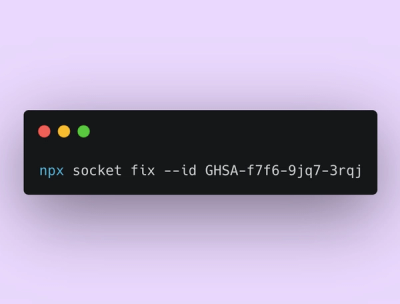
Product
Rust Support Now in Beta
Socket's Rust support is moving to Beta: all users can scan Cargo projects and generate SBOMs, including Cargo.toml-only crates, with Rust-aware supply chain checks.
Actively maintained, pure Python wrapper for the Twitter API. Supports both normal and streaming Twitter APIs
Twython is a Python library providing an easy way to access Twitter data. Supports Python 3. It's been battle tested by companies, educational institutions and individuals alike. Try it today!
Note: As of Twython 3.7.0, there's a general call for maintainers put out. If you find the project useful and want to help out, reach out to Ryan with the info from the bottom of this README. Great open source project to get your feet wet with!
Install Twython via pip:
$ pip install twython
If you're on a legacy project that needs Python 2.7 support, you can install the last version of Twython that supported 2.7:
pip install twython==3.7.0`
Or, if you want the code that is currently on GitHub:
git clone git://github.com/ryanmcgrath/twython.git
cd twython
python setup.py install
Documentation is available at https://twython.readthedocs.io/en/latest/
First, you'll want to head over to https://apps.twitter.com and register an application!
After you register, grab your applications Consumer Key and Consumer Secret from the application details tab.
The most common type of authentication is Twitter user authentication using OAuth 1. If you're a web app planning to have users sign up with their Twitter account and interact with their timelines, updating their status, and stuff like that this is the authentication for you!
First, you'll want to import Twython
from twython import Twython
Now, you'll want to create a Twython instance with your Consumer Key and Consumer Secret:
APP_KEY = 'YOUR_APP_KEY'
APP_SECRET = 'YOUR_APP_SECRET'
twitter = Twython(APP_KEY, APP_SECRET)
auth = twitter.get_authentication_tokens(callback_url='http://mysite.com/callback')
From the auth variable, save the oauth_token and oauth_token_secret for later use (these are not the final auth tokens). In Django or other web frameworks, you might want to store it to a session variable
OAUTH_TOKEN = auth['oauth_token']
OAUTH_TOKEN_SECRET = auth['oauth_token_secret']
Send the user to the authentication url, you can obtain it by accessing
auth['auth_url']
If your application is a Desktop or Mobile Application oauth_verifier will be the PIN code
After they authorize your application to access some of their account details, they'll be redirected to the callback url you specified in get_authentication_tokens.
You'll want to extract the oauth_verifier from the url.
Django example:
oauth_verifier = request.GET['oauth_verifier']
Now that you have the oauth_verifier stored to a variable, you'll want to create a new instance of Twython and grab the final user tokens
twitter = Twython(
APP_KEY, APP_SECRET,
OAUTH_TOKEN, OAUTH_TOKEN_SECRET
)
final_step = twitter.get_authorized_tokens(oauth_verifier)
Once you have the final user tokens, store them in a database for later use::
OAUTH_TOKEN = final_step['oauth_token']
OAUTH_TOKEN_SECRET = final_step['oauth_token_secret']
For OAuth 2 (Application Only, read-only) authentication, see our documentation.
Keyword arguments to functions are mapped to the functions available for each endpoint in the Twitter API docs. Doing this allows us to be incredibly flexible in querying the Twitter API, so changes to the API aren't held up from you using them by this library.
Function definitions (i.e. get_home_timeline()) can be found by reading over twython/endpoints.py
Create a Twython instance with your application keys and the users OAuth tokens
from twython import Twython
twitter = Twython(APP_KEY, APP_SECRET, OAUTH_TOKEN, OAUTH_TOKEN_SECRET)
twitter.get_home_timeline()
This method makes use of dynamic arguments, read more about them.
twitter.update_status(status='See how easy using Twython is!')
My hope is that Twython is so simple that you'd never have to ask any questions, but if you feel the need to contact me for this (or other) reasons, you can hit me up at ryan@venodesigns.net.
Or if I'm to busy to answer, feel free to ping mikeh@ydekproductions.com as well.
Follow us on Twitter:
Twython is useful, but ultimately only as useful as the people using it (say that ten times fast!). If you'd like to help, write example code, contribute patches, document things on the wiki, tweet about it. Your help is always appreciated!
html_for_tweet() parsingreturn_pages keyword argumentcreate_metadata endpointhtml_for_tweet()Twython.html_for_tweet()Twython.html_for_tweet()Twython.upload_video()upload_video endpointhtml_for_tweethtml_for_tweet method response when hashtag/mention is a substring of anotherlookup_status function to endpoints.pycursor to return full pages rather than individual resultscursor now uses while loop rather than recursionresponses to mock API calls in testsretry_after attribute to TwythonRateLimitErrorupload_media method to Twython in favor of update_with_mediaupdate_with_media per Twitter API 1.1 (https://dev.twitter.com/rest/reference/post/statuses/update_with_media)requests and requests-oauthlib in requirements.txtrequests version to 2.1.0.Exceptions in handlers or on_success which subclass ValueError would previously be caught and reported as a JSON decoding problem, and on_error() would be called (with status_code=200)get_authorized_tokenssetup causing installation to fail on some devices (eg. Nokia N9/MeeGo)html_for_tweet static method. This method accepts a tweet object returned from a Twitter API call and will return a string with urls, mentions and hashtags in the tweet replaced with HTML.client_args to the streaming __init__, much like in core Twython (you can pass headers, timeout, hooks, proxies, etc.).handlers which accepts a list of strings related to functions that are apart of the Streaming class and start with "on_". i.e. ['delete'] is passed, when 'delete' is received from a stream response; on_delete will be called.RequestException is raised, it is caught and a TwythonError is raised instead for convenience.iter_mode will be able to be passed to Twython.cursor and returned as a generator.Twython.search_gen has been deprecated. Please use twitter.cursor(twitter.search, q='your_query') instead, where twitter is your Twython instance.get_list_memberships, get_twitter_configuration, get_supported_languages, get_privacy_policy, get_tosauth_endpoint parameter to Twython.__init__ for cases when the right parameters weren't being shown during the authentication step._transparent_params so when passed True or False or an array, etc. Twython formats it to meet Twitter parameter standards (i.e. ['ryanmcgrath', 'mikehelmick', 'twitterapi'] would convert to string 'ryanmcgrath,mikehelmick,twitterapi')twython/twython.py to twython/api.py in attempt to make structure look a little neatergetHomeTimeline is now get_home_timeline)shorten_url. With the requests library, shortening a URL on your own is simple enoughtwitter_token, twitter_secret and callback_url are no longer passed to Twython.__init__
twitter_token and twitter_secret have been replaced with app_key and app_secret respectivelycallback_url is now passed through Twython.get_authentication_tokenstest_twython.py docstrings per http://www.python.org/dev/peps/pep-0257/get_list_memberships, method is Twitter API 1.0 deprecatedendpoints.py now contains EndpointsMixin (rather than the previous api_table dict) for Twython, which enables Twython to use functions declared in the Mixin.obtain_access_token to obtain an OAuth 2 Application Only read-only access tokenconstruct_api_url now accepts keyword arguments like other Twython methods (e.g. instead of passing {'q': 'twitter', 'result_type': 'recent'}, pass q='twitter', result_type='recent')client_args to the Twython __init__ to manipulate request variables. client_args accepts a dictionary of keywords and values that accepted by requests (Session API <http://docs.python-requests.org/en/latest/api/#sessionapi>_) [ex. headers, proxies, verify(SSL verification)] and the "request" section directly below it.get_application_rate_limit_status API method for returning the current rate limits for the specified sourceinvalidate_token API method which allows registed apps to revoke an access token presenting its client credentialsget_lastfunction_header now accepts a default_return_value parameter. This means that if you pass a second value (ex. Twython.get_lastfunction_header('x-rate-limit-remaining', 0)) and the value is not found, it returns your default valuesearch_genget_lastfunction_header to actually do what its docstring says, returns None if header is not found__init__ didn't need to have self.auth and self.headers because they were never used anywhere else but the __init__disconnect method to TwythonStreamer, allowing users to disconnect as they desireTwythonStreamError docstring, also allow importing it from twythonTwythonStreamError when stream line can't be decoded. Instead, sends signal to TwythonStreamer.on_errorget_retweeters_ids methodTwythonDeprecationWarning on camelCase functions if the camelCase was the same as the PEP8 function (i.e. Twython.retweet did not change)get_authentication_tokens to accomedate those using OOB authorization (non web clients)__repr__ definition for Twython, when calling only returning <Twython: APP_KEY>Twython.construct_api_url, uses "transparent" parameters (see 4th bullet in this version for explaination)requests and requests-oauthlib requirements, fixing posting files AND post data together, making authenticated requests in general in Python 3.3updateStatus() is now update_status())TwythonStreamer to aid users in a friendly streaming experience (streaming examples in examples and README's have been updated as well)Twython now requires requests-oauthlib 0.3.1, fixes #154 (unable to upload media when sending POST data with the file)HISTORY.rst to start tracking history of changestwitter_endpoints.py to endpoints.py for cleanlinesscompat.py for compatability with Python 2.6 and greater__author__ to __init__.pyversion.py to store the current Twython version, instead of repeating it twice -- it also had to go into it's own file because of dependencies of requests and requests-oauthlib, install would fail because those libraries weren't installed yet (on fresh install of Twython)find_packages() from setup.py, only one package (we can just define it)python setup.py publish is faster to type and easier to remember than python setup.py sdist uploadbase_url from endpoints.py because we're just repeating it in Twython.__init__Twython.get_authentication_tokens() now takes callback_url argument rather than passing the callback_url through Twython.__init__, callback_url is only used in the get_authentication_tokens method and nowhere else (kept in init though for backwards compatability)warnings.simplefilter('default') line in twython.py for Python 2.7 and greater to display Deprecation Warnings in consoletwitter_token, twitter_secret and callback_url in Twython.__init__requests isn't greedy about variables that can't be converted to unicode anymorebulkUserLookup (please use lookupUser instead), removed getProfileImageUrl (will be completely removed from Twitter API on May 7th, 2013)requests makes it easy for developers to implement their own url shortening in their app (see https://github.com/ryanmcgrath/twython/issues/184)ssl_verify parameter, defaults True. Set False if you're having development server issues_media_update function, we could have always just used self.postAttributeError when trying to decode the JSON response via Response.json()simplejson dependencydestroyDirectMessage, createBlock, destroyBlock endpoints in twitter_endpoints.pygetProfileBannerSizes method to twitter_endpoints.pyget_authorized_tokensupdateProfileBannerImage to use v1.1 endpointshowOwnedLists methodgetMentionsTimeline in twitter_endpoints.pytwitter_endpoints.py to better reflect order of API endpoints on the Twitter API v1.1 docs siteFAQs
Actively maintained, pure Python wrapper for the Twitter API. Supports both normal and streaming Twitter APIs
We found that twython demonstrated a healthy version release cadence and project activity because the last version was released less than a year ago. It has 2 open source maintainers collaborating on the project.
Did you know?

Socket for GitHub automatically highlights issues in each pull request and monitors the health of all your open source dependencies. Discover the contents of your packages and block harmful activity before you install or update your dependencies.

Product
Socket's Rust support is moving to Beta: all users can scan Cargo projects and generate SBOMs, including Cargo.toml-only crates, with Rust-aware supply chain checks.

Product
Socket Fix 2.0 brings targeted CVE remediation, smarter upgrade planning, and broader ecosystem support to help developers get to zero alerts.

Security News
Socket CEO Feross Aboukhadijeh joins Risky Business Weekly to unpack recent npm phishing attacks, their limited impact, and the risks if attackers get smarter.